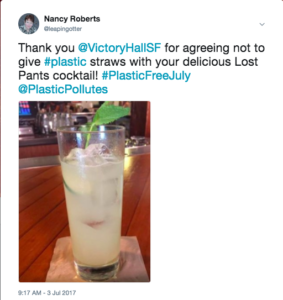
At Gigantic, we work hard to “get inside the heads” of the audiences we try to reach. How difficult is it to get someone to change behavior, even to be aware of that behavior? I experimented on myself last month, when I joined the #PlasticFreeJuly movement, and tried to avoid buying or accepting anything made of plastic for 31 days.
The first thing I noticed was anxiety, and a tendency to over-compensate. Should I stock up on plastic on June 30 so I could get through the month comfortably? What would I have to give up? Just how uncomfortable is this change going to be?
How can a behavior change specialist address her own fears of change and scarcity?
The Thrill of Failure
My first day was a failure, but also a tremendous success. I went out to lunch and ordered a cocktail (it’s OK, it was a Saturday!) The drink came with a straw – I had forgotten to ask for no straw. Disaster in the first few hours of the experiment! I posted about my personal failure to Facebook and Twitter, tagging the restaurant. I was amazed to see several supportive comments, even from “non-green” people with whom I had not interacted in years, saying they, too, were sick of plastic and that I should keep trying. Then, lo and behold, the restaurant responded to me via Facebook, saying that they, too, loved this particular cocktail and from now on would serve it without a straw. Victory! I took away from this experience that it can be more effective to post about one’s own weakness, to acknowledge error, rather than trying to be a brave and mighty eco-hero.
Challenges kept on coming throughout the month. In some cases there were joyous substitutions – I discovered that bread sliced at the bakery and wrapped in paper did just fine in the freezer, so breakfast was set.
Plastic = Convenience
As the month wore on, I realized that plastic equals convenience, and that I had to re-align my idea of what was convenient. Yes, it takes longer to bring your own containers and use the bulk bins of the market. It takes more effort to go to the cheese shop where the owner was happy to wrap my slices in paper – not an option at the supermarket. On the flip side, I had wonderful conversations with folks behind the counter; some were bemused by my requests, some were delighted. But this was an opportunity to connect with people in my neighborhood whom I had, frankly, barely noticed before. How to translate this greater feeling of community to our work?
When To Give Up
In some cases, going plastic-free meant going without. Tortillas and potato chips, indeed all salty junk food, were not an option, unless ordered in a restaurant. I had to cheat in a couple of instances, choosing less plastic over no plastic for things like toothpaste and olive oil. Luckily I don’t take a lot of medicines, but when I ran out of Vitamin D…I caved and bought more in a plastic bottle. I noticed the feeling of guilt and this time I did not share my “failure.”
It’s August now, and I have relented a bit, but the plastic-free exercise has stuck with me. The main thing I took away from July was a heightened awareness of plastic’s never ending presence in our lives. Entire aisles of the supermarket were off limits – which after a while felt quite restful. Connecting this ubiquity with the fact that of the 8.3 billion metric tons of plastic ever made, 6.3 billion metric tons have become plastic waste, with no end in sight. After this experiment, I am reminded as we plan campaigns that in many cases we are asking people to change, to give up something, to be inconvenienced. These are big asks. While these changes seem essential and even joyful to those of us in the environmental field, I believe it is essential to integrate humility and understanding into our campaigns, so that people feel understood and supported as we travel together on this journey to more sustainable living.